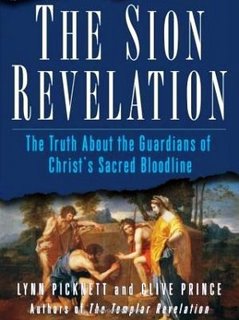 However in Clive Prince & Lynn Picknett's recent The Sion Revelation we finally have a work (which the authors say is the product of ten years research) that looks beyond the it’s-all-true/ it’s-all-rubbish categorically opposed positions of the believers and the debunkers. It explores in detail the background politics behind the Priory as a front organisation that emerged from the war, adopting the French Resistance’s use of innocuous-seeming messages, such as lines of poetry, as codes. (This is a technique that will be familiar to anyone who has seen or read The Longest Day). It traces how the principal ‘hoaxer’ Plantard was aiding one contender after another who might be a strong, traditionalist leader of France: first the wartime collaborationist Vichy Regime of Marshall Petain, then De Gaulle in his 1950s comeback, and finally President Mitterrand around 1980, when HBHG was being prepared.
However in Clive Prince & Lynn Picknett's recent The Sion Revelation we finally have a work (which the authors say is the product of ten years research) that looks beyond the it’s-all-true/ it’s-all-rubbish categorically opposed positions of the believers and the debunkers. It explores in detail the background politics behind the Priory as a front organisation that emerged from the war, adopting the French Resistance’s use of innocuous-seeming messages, such as lines of poetry, as codes. (This is a technique that will be familiar to anyone who has seen or read The Longest Day). It traces how the principal ‘hoaxer’ Plantard was aiding one contender after another who might be a strong, traditionalist leader of France: first the wartime collaborationist Vichy Regime of Marshall Petain, then De Gaulle in his 1950s comeback, and finally President Mitterrand around 1980, when HBHG was being prepared.It goes back over the planting in the national archives of each batch of Les Dossiers Secrets which were the basis of much of HBHG, each adding to or modifying the scenario to manipulate the HBHG and later authors in a semi-improvised campaign of disinformation and misdirection. In fact, it largely goes over the same ground as HBGH but offers a revisionist political interpretation of events in the light of post-1982 evidence. For instance, Sauniere, the 19th-C. parish priest at the centre of the Rennes mystery, is characterised as mainly a virulent opponent of Republicanism, which he equated with a 'Judeo-Masonic' [sic] conspiracy. He used much of his mysterious wealth (which the authors suggest was payment for hunting for key genealogical documents proving local land titles, rather than by blackmailing the Vatican or finding a gold hoard) to redecorate his church in unorthodox ways some have taken as treasure clues. He did this as a protest at the defilement of the French church which since Napoleon were state-supervised, operating under the thumb of the hated Republic, and his actions caused a rift with church superiors, who suspended him.
It also challenges the professional debunkers for accepting stories (like the one that Plantard admitted to a judge he had made the whole thing up) without evidence – the sin they accused others of. The debunkers were also so focussed on doing an expose they didn’t enquire too closely into the motives for such a long-lasting prank or hoax and the subsequent ‘admissions’ e.g. by the Marquis de Cherisey that he had made the whole code up himself as a harmless prank, a puzzle for others to solve. The book says the de Cherisey code is in fact unbreakable even using modern computer analysis, since it depends on possessing the alphabetic key, as with the “onetime pads” used by the Resistance. The key here turns out to be 128 letters long, an anagram reversing a gravestone inscription, with letters added from a second claimed (probably nonexistent) inscription, the result being shifted one letter down the alphabet, and then run twice through a “Knight’s Tour” (a form of encryption using a famously difficult chess manoeuvre to generate a unique, encircling chessboard pattern), and then through another letter-substitution grid invented by a mentor of Da Vinci, known as a Vigenere Square - twice, the 2nd time using a different and secret keyword. The end product in any case is itself a poetic riddle akin to a set of crossword clues jumbled together (supposedly local place-name treasure-hunt clues), about Poussin, Teniers, the horse of god, a demon guardian, and blue apples - which (as we know from that Timewatch documentary) is itself capable of more than one interpretation. Some puzzle!
They conclude Plantard was indeed a media hoaxer, but one acting from lifelong political interests on behalf of a cryptofascist movement with various fronts or faces, which is working to help put in place a Catholic-traditionalist style presidential equivalent of their roi perdu – France’s lost monarchy - which can contend for control of a united Europe.
PS As a result of reading an incidental passage in this book, I’ve also added a paragraph to my earlier item, Was What Sauniere Found A ‘Codex’?





